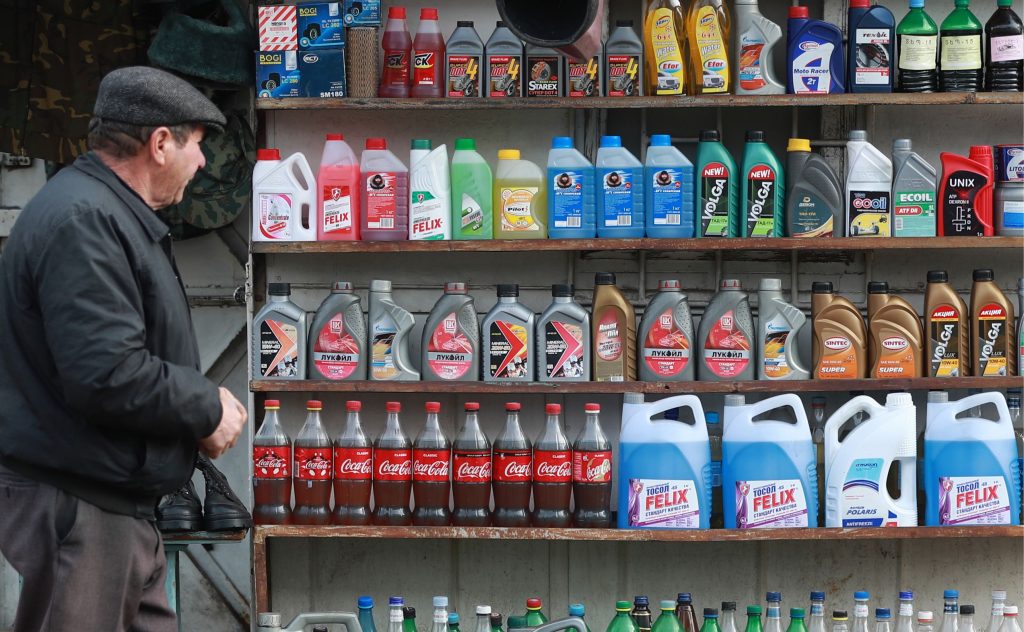What Color Is Coolant Supposed to Be
Even outside of oil, a significant part of vehicle maintenance involves taking care of fluids. And while EVs don't have motor oil, they do still need coolant. However, just like it's easy to be overwhelmed by oil grades, it can be challenging to know what coolant to pick. Especially when it's available in such a variety of colors and standards. But it doesn't have to be.
Coolant and antifreeze colors and standards

Although 'coolant' and 'antifreeze' are often used interchangeably, they're not quite the same thing. Antifreeze is a mixture of various chemicals, with ethylene glycol being the main ingredient, Bumper reports. Meanwhile, the term 'coolant' can refer to plain water, straight antifreeze, or a mix of the two. What's typically sold in stores is a 50/50 mix of the two, combining water's excellent heat transfer properties with antifreeze's low freezing point, NAPA explains. And you do need at least a 70/30 antifreeze/water mix for the best results.
Typically, Valvoline says, coolant comes in green. But there are other colors available: orange, blue, purple, even yellow and pink. However, they're not different colors for appearance's sake. Each manufacturer designs its engines around a specific coolant or antifreeze standard with different additives. GM, for example, uses orange-colored Dex-Cool antifreeze, while VW's preferred coolants are typically yellow- or blue-colored, Hemmings reports.
These different types of antifreeze all do broadly the same things. They prevent water from freezing and boiling off and inhibit corrosion and mineral deposits in the radiator. Plus, they can extend the life of your cooling system's rubber hoses. Yet another reason why cars don't do well if they stay idle or in storage for too long.
But despite having the same overall goal, a green coolant can't necessarily stand in for an orange one. Or be mixed.
Can I mix colors?
There's a bit of conflicting advice when it comes to mixing coolant colors. For example, Valvoline states never to mix them on one page but claims it's OK on another. And as the video above shows, some antifreeze suppliers claim mixing their product with others causes no issues.
Ultimately, ItStillRuns explains, it's not about the color, but the coolant itself. The problem with mixing green antifreeze and orange Dex-Cool is that they're based on different chemistries, Autoblog explains. The former combines ethylene glycol with silicates, phosphates, and inorganic acids, Hemmings explains. The latter, though, contains propylene glycol and organic acids. When the two mix, they create a gel that gums up your cooling system, causing engine overheating and expensive damage.
But orange-and-green is the only coolant combination you need to stay clear of, CarBibles reports. Many automakers today use hybrid-inorganic-organic-acid antifreeze, which combines the properties of both chemistries. But the best coolant is the one the manufacturer lists in your car's owner's manual.
Changing your coolant

Although some manufacturers don't list coolant on their maintenance schedules, Cars.com reports, it's by no means a lifetime fluid. Even Tesla recommends changing the Model 3's coolant every 4 years or 50,000 miles, Roadshow reports. The only vehicles which don't need a coolant change are ones without any to begin with, such as Janus' and BMW's air-cooled bikes.
It deteriorates over time, becoming more acidic and losing its protective properties. Dex-Cool was the subject of several class-action suits because it caused rust and gasket degradation. And your coolant doesn't just keep the engine cool; it's why your heater works, too, Haynes explains.
RELATED: Consumer Reports: These Vehicles Blow Head Gaskets
Luckily, there are a few ways to see if your coolant is due for replacement, MotorWeek reports. One is a visual check. If it looks milky or cloudy, or has particulates floating in it, flush the system, Hagerty reports. You can also use a hydrometer to test for the fluid's freeze protection.
But the best way is to measure its acidity, using either litmus paper or a voltage meter, Family Handyman reports. If the meter reads above 0.4 volts or the pH reads below a certain value, it's time for new fluid.
Fluid replacement and radiator flushing
RELATED: Your Car's A/C May Be Due for a Recharge
Replacing your coolant is fairly straightforward, Advanced Auto Parts reports. First, open the radiator and coolant reservoir caps. Then, find the radiator's drain (aka 'petcock'), and let the fluid drain. If you're planning on flushing the radiator, add the flush chemical, close all the caps, and run the engine with the heater on high until it reaches operating temperature.
After letting it cool, drain the flush compound, replace it with water, and run the same steps again. Drain the water, and replace it with the recommended coolant. There's going to be some air bubbles that need to be removed so your engine won't overheat. So, run the engine with the new coolant with the radiator cap off to let them escape. Afterward, add enough fluid to reach the 'Full' line on the reservoir.
Follow more updates from MotorBiscuit on our Facebook page.
RELATED: The Most Common Reasons You Car Heater Isn't Working
What Color Is Coolant Supposed to Be
Source: https://www.motorbiscuit.com/does-the-color-of-your-coolant-matter/